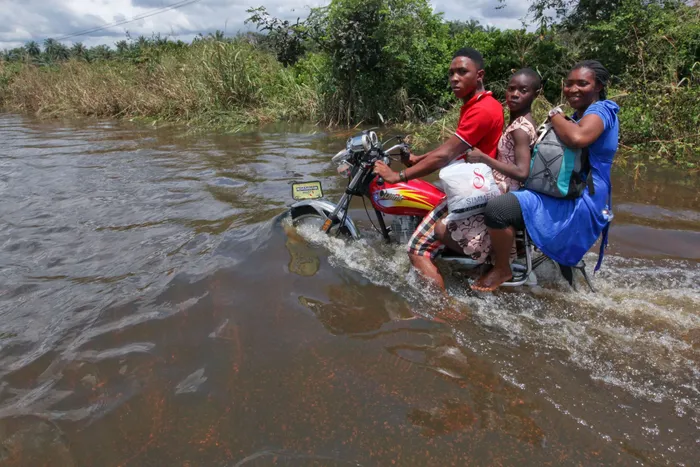Nigeria floods: Crisis exacerbated by climate change

Picture credit: REUTERS/Afolabi Sotunde - In this file picture, a man rides a motorcycle with passengers along a flooded road in the Patani community in Nigeria's Delta state.
Picture credit: REUTERS/Afolabi Sotunde – People sit in front of a submerged building in the Patani community in Nigeria's Delta state.
By Chad Williams
Across Nigeria, Africa’s most-populous country, devastating floods continue to ravage farmlands, destroy crops and force tens of thousands of people to abandon their homes.
To date, at least 300 people have been killed in the floods. It is believed that some 100,000 people have been displaced and are living in temporary shelters, according to local media reports.
In the farming town of Tiga, 70km outside Kano in the north of the country, people have been particularly hard hit.
The flooding has affected an estimated half a million people and destroyed infrastructure and farmland in 27 of Nigeria’s 36 states and the capital city.
As we’ve seen in Pakistan in recent weeks, flooding events are becoming more and more devastating.
Tiga rice farmer, Adamu Garba told Reuters recently in an interview that his field has become completely barren. He said after the flood subsided, the rice was killed. Then another disaster occurred. The bridge was washed away by the rain, which deposited sand and broken bitumen, covering the entire field.
Lagos is dangerously close to sea level, together with Bayelsa and Delta states, the Nigerian states which face the highest risk of flooding, threatening more than 20 million people, Nigeria Hydrological Services Agency says.
Home to more than 24 million people, Lagos, a low-lying city on Nigeria’s Atlantic coast.
Scientists say that the city may become uninhabitable by the end of this century as sea levels rise due to climate change, scientific projections suggest.
The Nigerian government on July 30, 2021 submitted to the United Nations Framework Convention on Climate Change (UNFCCC) its first Nationally Determined Contributions (NDC) - the heart of the Paris Agreement encapsulating the post-2020 climate actions by countries to reduce greenhouse gas emission and adapt to the impacts of climate change.
Nigeria’s climate is changing, and this is evident in increases in temperature; variable rainfall; rise in sea level and flooding; drought and desertification; land degradation; more frequent extreme weather events; affected fresh water resources and loss of biodiversity, according to the UN Office for Disaster Risk Reduction.

The durations and intensities of rainfall have increased, producing large run-offs and flooding in many places in Nigeria.
Rainfall variation is projected to continue to increase. Precipitation in southern areas is expected to rise and rising sea levels are expected to exacerbate flooding and submersion of coastal lands, says the UN, in essentially what is a warning to not only Nigeria, but to the world to take heed that global warming is here.
I would have to agree with the 2022 Foresight Africa report on Climate Change, that Africa’s policymakers should not be passive recipients of what “others” can do for Africa in COP27, but instead, Africans should be well prepared and organised.
Williams is a journalist with the African News Agency (ANA)
This article is original to the The African. To republish, see terms and conditions.